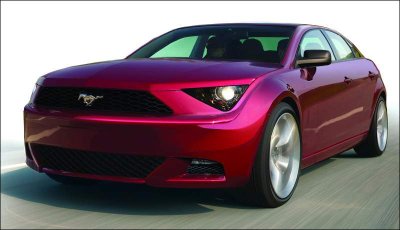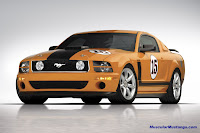Mustang 2007 information

For 2007, Mustang's bold American style is enhanced with two new appearance packages and a host of interior and equipment upgrades. Additional features include available heated front seats, a standard auxiliary audio input jack and optional SIRIUS satellite radio. Yet another Mustang first, a DVD-based navigation system, will be available shortly after the 2007 model year launches.
Mustang is one of the greatest automotive sales success stories of all time. Nearly one out of every two sports cars sold in America is a Mustang, and Mustang remains one of the hottest-selling cars in America. It’s also America’s best-selling convertible.
Mustang coupe and convertible body styles are offered in four models: V6 Deluxe, V6 Premium, GT Deluxe and GT Premium.
All Mustangs are built in Flat Rock, Mich.
Design and Equipment
Mustang is pure American muscle. The signature long hood and short rear deck capitalize on 40 years of history, as do classic design cues that have defined Mustangs since the 1960s: C-scoops in the sides, three-element taillamps, and a galloping horse badge in the center of the grille. The Mustang’s menacing shark-like nose imparts an attitude not seen since the 1967 model, while jeweled, round headlamps in trapezoidal housings are part of its modern architecture. The car’s aggressive rake gives the design visual motion, while the short overhangs and up to 18-inch wheels and tires anchor the design visually and physically to the road.
For 2007, GT models are available with a new GT California Special edition and the GT appearance package.
The Mustang GT California Special is available on GT Premium models and includes 18-inch wheels, side scoops, unique tape stripes, rolled bright exhaust tips, black leather trimmed seats with unique “Cal Special” contrasting Dove or Parchment leather inserts, a larger air intake, a chin spoiler 1.5 inches lower than GT, and unique front and rear fascias.
The GT appearance package features rolled exhaust tips, an engine cover with a Pony emblem and a hood scoop.
The GT California Special and GT appearance packages can be ordered separately or combined to give Mustang enthusiasts one of the most expressive Mustang GTs ever offered.
A comfort group package is new for 2007. Available on V6 and GT models, it includes an electrochromic mirror with compass, driver and front-passenger heated seats, and a six-way power passenger seat. Also new is a standard auxiliary audio input jack and available SIRIUS satellite radio.
For V-6 buyers, the Pony Package includes a customized grille with GT-style round fog lamps and a chrome bezel, or “corral,” around the traditional Mustang prancing horse. Backing up this visual upgrade is a GT-inspired suspension featuring a larger front stabilizer bar, the addition of a rear stabilizer bar and P235/55ZR17 tires on painted cast-aluminum wheels. With bright machined rims and unique tri-bar Pony center caps, these are the largest factory wheels and tires ever fitted to a V-6 Mustang.
Further touches include Pony front fender badges, lower door tape stripe, carpeted front floor mats with special brushed chrome “Mustang” logos and a rear spoiler.
Inside, the industry-first, color-configurable instrument panel offers the ultimate in personalization. Mustang owners can mix and match lighting at the touch of a button to create more than 125 color backgrounds to suit their personalities, moods, outfits or whims.
Modern touches mix with Mustang history and heritage. Chrome-ringed air vents are aligned vertically across the dash, precisely in line with the gauges, and the steering wheel has three spokes with a center hub marked by the horse and tricolor bars logo, echoing the design of the 1967 Mustang.
Numerous standard features include one-touch up-down power windows, power mirrors, keyless entry and power locks, a heated rear window, interval wipers, air conditioning, speed control and a CD player.
Powertrain and Chassis
Muscular engines infuse Mustang with tire-smoking performance. The 4.6-liter, aluminum V-8 has three valve heads and cranks out 300 horsepower. That’s more than 50 percent more power than the small-block, 289-cubic-inch V-8 found in the classic 1964 model.
The standard engine, a 60-degree, 4.0-liter, single-overhead-cam V-6, produces 210 horsepower and 240 foot-pounds of torque.
Both engines are paired with a standard five-speed manual or an available five-speed automatic, which provides a unique combination of off-the-line jump and good highway fuel economy.
At the front suspension, MacPherson struts with reverse “L” lower control arms deliver comfort. The three-link rear suspension has a lightweight, tubular Panhard rod that provides precise control of the rear axle. This technology stabilizes the rear axle as the wheels move, particularly during hard cornering.
The standard four-wheel disc brakes have the biggest rotors and stiffest calipers ever fitted to a mainstream Mustang. Twin-piston aluminum calipers clamp down on 12.4-inch ventilated front brake discs on GT models. In the rear, the brake rotors are 11.8 inches in diameter.
A four-channel anti-lock brake system (ABS) with traction control is standard on GT models and available on V-6 models. It uses electronic sensors to constantly monitor road conditions and feed the information to a dedicated control computer that’s capable of determining within milliseconds whether the vehicle is on dry pavement or negotiating a slippery surface. When traction control isn’t desired, drivers can deactivate the system with a button on the instrument panel.
Safety and Security
With power comes responsibility. The 2007 Mustang helps occupants stay safe.
Ford’s Personal Safety System®, a comprehensive safety technology package, is standard. The system provides increased protection in frontal crashes by analyzing crash factors and determining the proper response within milliseconds. It uses dual-stage driver and front-passenger air bags — capable of deploying at full or partial power — safety belt pretensioners and energy management retractors.
Standard right front passenger sensing builds on the strength of the Personal Safety System ® to tailor deployment of the front-passenger air bag. If the passenger seat sensor detects no or very little weight, as for a briefcase, the passenger air bag is automatically switched off. If more weight is on the seat, as for a small child, the air bag remains deactivated and an instrument panel light alerts the driver. If a heavier adult is in the passenger seat, the air bag automatically switches on.
An optional active anti-theft package offers customers an added level of security. It includes a sensing module to guard against tow-away thefts, an interior motion sensor to detect smash-and-grab break-ins, a separate alarm sounder — in addition to the vehicle horn — to thwart thieves trying to disable the horn, and a high-capacity, 60-ampere-hour battery that sounds the alarm longer.
Major Features and Options
V-6 Deluxe: auxiliary audio input jack, one-touch up-down power windows, power mirrors and door locks, keyless entry, air conditioning, CD player, tilt steering wheel, speed control, rear window defroster, stainless steel exhaust, 16-inch wheels, four-wheel power disc brakes, and split-folding rear seat on coupe models.
V-6 Premium adds: 16-inch, painted, bright machined-aluminum wheels with chrome spinner; Shaker 500 audio system with six-disc CD changer and MP3 capability; and six-way power-adjustable driver seat.
GT Deluxe adds: 4.6-liter, three-valve, V-8 engine; ABS with traction control; stainless steel dual exhaust; front fog lamps in grille; complex reflector halogen headlamps with integral turn signals; rear spoiler; performance tires with 17-inch, painted cast-aluminum wheels; AM/FM audio system with single CD; cloth sport bucket seats; and tilt steering wheel.
GT Premium adds: Shaker 500 audio system with six-disc CD player, and Aberdeen leather-trimmed, embossed sport bucket seats.
Options include: GT California Special Package; GT appearance package; comfort group; SIRIUS satellite radio; V-6 Pony Package; seat-mounted side air bags; interior upgrade package with satin-aluminum trim or dark aluminum trim; MyColor custom instrument panel; interior color accent package with black interior and red seats and door inserts; five-speed automatic transmission; two styles of 18-inch, cast-aluminum wheels; and active anti-theft system.































































